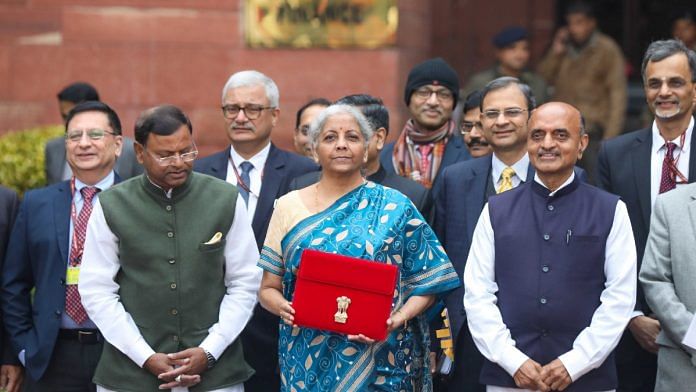Searching for the biggest political takeaway in Nirmala Sitharaman’s pre-election budget is what you won’t find luck with even on a most thorough reading.
It’s the missing “P” of populism. No giveaways, welfare schemes, tax cuts, exemptions. Nothing.
Read this budget, therefore, as a declaration of victory a month before Lok Sabha elections are announced.
This is something old-timers like us have forgotten to expect. Later generations, or those that started voting 1989 onwards, wouldn’t have seen something that looks so bland. This blandness is the statement of electoral confidence, and the key message from the budget.
It was quite some time back that a pre-election budget ceased to be a mere vote-on-account, to carry on government spending until the newly elected government came with a full budget mid-year. In the course of time, this vote-on-account became an interim budget.
Compare this year’s statement with what Piyush Goyal presented ahead of elections in 2019. It launched PM Kisan, a welfare scheme as wide in its political impact as in financial cost. It raised income tax slabs at several levels, bringing relief, and brought in some other important, and voter-friendly changes.
This one has none. Even the rooftop solar scheme was one Prime Minister Narendra Modi had already unveiled on the day of the Ram temple consecration. The rest is just a continuation, and some expansion (housing for the poor) of existing schemes.
The absence of populism, however, should not be misread as that of politics. Nothing the Modi government says or does is ever without politics. The standout point here is a formidable counter to the two most important lines of attack the BJP typically faces from its challengers: on social justice, and secularism.
The words “social justice” and “secularism” feature three times and once, respectively. Much of INDIA bloc’s new campaign is built on caste-based social justice, with promises on caste censuses and distribution of benefits in accordance with each group’s numbers.
Also Read: Ayodhya wasn’t Republic’s end. BJP’s challengers can learn from Indira’s fall, Modi’s rise
As its first political counter, the BJP lured back Nitish Kumar, the caste census man of the match. The social justice section in the budget seeks to give it a completely different meaning. Defining its approach to development as “all round, all pervasive and all inclusive”, it says it “covers all castes and people at all levels”. After elaborating on this a bit more, it says “previously, social justice was just a political slogan”.
For this government, Sitharaman said, “social justice is an effective and necessary governance model” and “saturation approach of covering all eligible people is the true and comprehensive social justice”.
This is where secularism is also shoe-horned into the proposition. “This is secularism in action, she says”. A longtime reader of Indian politics will put it under the box: where the Modi-Shah BJP hyphenates social justice with secularism and tries to counter both with its “sabka saath, sabka vikaas”.
This is a carefully crafted political pitch. “The resources are distributed fairly. All regardless of their social standing get access to opportunities,” Sitharaman says. The idea is to “address systemic inequalities that had plagued our society”. The political pitch is to divorce socio-economic status and a share of national resources from identity.
Domain experts and economists will look at the numbers. I find it a significant positive that an incumbent is going to the polls claiming a track record of building infrastructure, physical assets as well as virtual, and makes a larger allocation for the new year. If infra becomes a vote-catching factor, it is a significant positive for Indian politics.
Think about it. The same budget could’ve doubled the giveaways under PM Kisan instead. That it wasn’t done tells us three things. One, that the BJP is confident of winning, even nonchalant. Two, that it thinks things like infrastructure, more educational institutions and soft entrepreneurial loans will work quite well instead. And third, that it isn’t willing to suspend its fiscal caution in an election year.
That’s why another significant takeaway is the government claiming credit for not only keeping its commitment on fiscal deficit, but pulling it back marginally. This is what isn’t expected in an election year when you generally expect a spending spree; the fiscal discipline had better wait for next year.
There are, of course, other elements we must take note of, and not all are positive. The big negative, in our book, would be an indication that the government is losing interest in disinvestment.
Earlier targets have been missed, and the new one is really low. It will probably be said that the PSU stock prices and valuations have gone up, so why sell them. But then, the excuse for not selling when stock prices are low is precisely this: why sell now when valuations are so poor. Let’s wait for when they get better.
It is tempting, and I’d believe safe, to draw the conclusion that philosophically, this BJP also lacks Atal Bihari Vajpayee’s commitment to privatisation. All governments enjoy being in business while arguing against it. Ideologically, that is one reform Indian politics still waits for. On the evidence from this full majority government over two terms yet, it looks like that wait only got longer.
Also Read: Congress just blew a Ram-given opportunity. It chose chronic confusion over national mood




Shouldn’t a decision on disinvestment be based on how it may benefit the entity/entities in which the stake sale would be carried out rather than simply to prove a point about the commitment to privatization? The recent approval granted to separately list NTPC’s green energy arm is good proof of the pragmatism at play with regard to unlocking value at well-run state-owned companies.